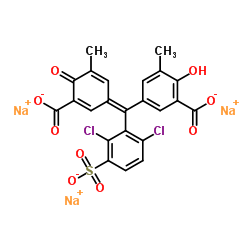Identification of erythrobactin, a hydroxamate-type siderophore produced by Saccharopolyspora erythraea.
P H Oliveira, A Batagov, J Ward, F Baganz, P Krabben
Index: Lett. Appl. Microbiol. 42(4) , 375-80, (2006)
Full Text: HTML
Abstract
To investigate the production of siderophores by Saccharopolyspora erythraea SGT2 and how this production is affected by the inoculum.When grown in a low-iron, chemically defined medium (CDM), the soil dwelling actinomycete S. erythraea secretes a substance that is reactive in the nonspecific chrome azurol S (CAS) assay. Importantly, the production of CAS-reactive substance is highly reduced upon the addition of 0.925 micromol l(-1) iron to the cultures and has a peak of production in the late-log to early stationary growth phase. In addition, the culture supernatants tested were negative in the Arnow and Rioux assays but positive in the Csáky procedure. Interestingly, we also found evidence that the production of this CAS-reactive substance in CDM was highly reduced, when inoculated with cells that had been previously grown to late-stationary phase. Conversely, inocula derived from late-log to early stationary cultures presented high levels of CAS activity.These results indicate that S. erythraea produces a hydroxamate-type siderophore that we have generically designated as erythrobactin. Additionally, the inocula growth stage plays a key role in siderophore production in S. erythraea.It is the first evidence for siderophore synthesis in S. erythraea and one of the first examples of non-polyketide secondary metabolite production by this organism.
Related Compounds
| Structure | Name/CAS No. | Molecular Formula | Articles |
|---|---|---|---|
 |
Alberon
CAS:1667-99-8 |
C23H13Cl2Na3O9S |
|
Halloysite nanotubule clay for efficient water purification.
2013-09-15 [J. Colloid. Interface Sci. 406 , 121-9, (2013)] |
|
Predicting the composition of red wine blends using an array...
2015-01-01 [Molecules 20 , 9170-82, (2015)] |
|
Metachelins, mannosylated and N-oxidized coprogen-type sider...
2014-07-25 [J. Nat. Prod. 77(7) , 1685-92, (2014)] |
|
Using enantioselective indicator displacement assays to dete...
2008-09-17 [J. Am. Chem. Soc. 130(37) , 12318-27, (2008)] |
|
Characterization of disposable optical sensors for heavy met...
2012-05-30 [Talanta 94 , 123-32, (2012)] |